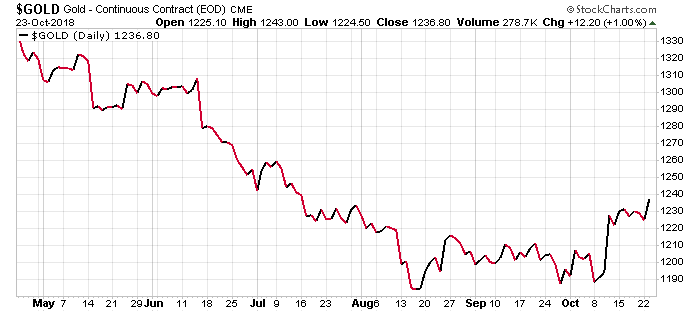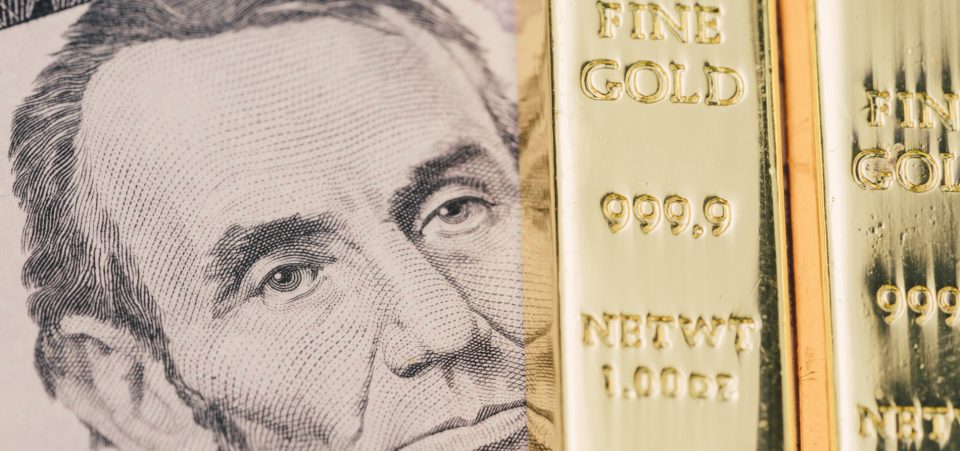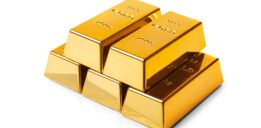Greater Risk Aversion Strengthens the Gold Price Rally
The gold price has resisted above $1,200 and appears to be ready for a robust run, as we expected.
A new gold price floor of $1,300 is within reach. And the fact that the silver price has achieved a bigger jolt in price—gaining over one percent on October 23 alone—suggests that precious metals are ready for a sustained rebound.
The gold price typically makes a substantial move toward a higher, and lasting, price range only after silver shows bullish support. Gold is finally responding to an overall sense of political and economic vulnerability—even more than volatility.
The United States is preparing for one of the most contested midterm elections in recent memory.
Americans are united about the name of their country and little else.
Meanwhile, America, the country, has clarified its overall approach to relations vis-à-vis friends and foes alike.
The CliffsNotes summary would condense that approach as: America against the world even more than “you’re either with us or against us.”
At first, it seemed that President Donald Trump would keep the pressure on China, threaten Iran, and promote friendly relations with Russia. Instead, Trump’s policy has overturned all the late-night TV show hosts’ caricatures of a lovefest between himself and President Vladimir Putin.
Gold Price to Gain From the Potential Controversy Ahead
Of the few ultra-loyal friends the U.S. has left (even the European Union shows more fear than friendship), some are abusing their privileges. Saudi Arabia, for one, has overstepped its boundaries, leaving Trump with an embarrassing dilemma.
That may infuse volatility in the financial markets, intensifying the already damaging effect of higher interest rates and higher Treasury yields.
The risk of an oil crisis has reared its ugly head, pushing prices to five-year highs.
Brent Crude oil prices have moved past $80.00 per barrel after Trump recognized the Saudi government as having instigated the murder of The Washington Post journalist Jamal Khashoggi in Istanbul, threatening significant consequences for the perpetrators.
Risk Aversion Is Back
The overall market has started to brace itself. In other words, risk aversion is back in fashion. The Dow has dropped almost 2,000 points after one of the most flagrant examples of irrational exuberance pushed it to a new record of 26,773 on October 2, 2018.
And, as many seasoned observers and students of the stock market know, October is full of ups and downs. It is both April and May in that famous Frank Sinatra song, That’s Life: “You’re riding high in April, shot down in May…”
Can this down period of the market be trusted to give the gold price the support it has been seeking?

Chart courtesy of StockCharts.com
The markets are dropping thanks to a real sense of risk aversion amid higher volatility. Therefore, the price of gold—the haven investment by definition—should enjoy the steady boost many precious metals investors have been seeking.
I have more reason for optimism, as far as the gold price goes. Gold has managed to make gains, however mild, even as the value of the U.S dollar has risen—threatening to go higher still as interest rates increase.
Gold prices suffer when the U.S. dollar gains. The higher interest rates threaten exactly that: to make the U.S. dollar more expensive.
And there are concerns that China will devalue the yuan, its currency, to offset the new tariffs on hundreds of the goods that the U.S. imports.
Risks From China to Russia, Europe, and Beyond
Yet, that’s a mere appetizer for what China could do to the markets and interest rates, should it ever decide to dump U.S. debt on the markets.
China owns a large chunk of U.S. debt; as much as $1.2 trillion. It also owns the debt of other Western powers. In other words, in case of a full-on global trade war, China can use the debt weapon against most Western powers—not just the United States.
All China has to do, as the owner of U.S. Treasuries, is demand the money back. At that point, the U.S. may decide to oblige, returning the debt. But doing so would cause the U.S. economy—in fact, the global economy—to collapse.
That option should have all investors concerned; especially if Trump’s trade war rhetoric intensifies. Regardless, the Federal Reserve will continue to raise interest rates.
And the fact that the gold price has continued to increase even in the face of clear evidence the U.S. dollar is going up shows the extent to which the sentiment on gold has changed.
Were investors and the markets less volatile, the textbook reaction to the prospect of gradual interest rate increases would have been to ignore gold.
The gold price, in other words, would have been allowed to drop below its support level as technical analysts describe what I prefer to call the floor or base price.
Pessimism Has Prevailed
The main reason the gold price has started to rise—and will continue to rise—comes down to this basic fact: Investors appear to have reached their peak tolerance for risk.
Investors all over the world are pessimistic.
Their high apprehension has heightened reactions to a series of geopolitical and economic issues that have worsened.
And they keep building. Few have noticed now, but President Trump has pulled out of the U.S.-Russia nuclear weapons agreement. That’s the very same agreement that President Ronald Reagan and Soviet leader Mikhail Gorbachev signed in Reykjavik, Iceland in 1987.
That’s the agreement that unraveled the Cold War.
After years of fearing a nuclear holocaust, millions of people around the world saw great and genuine hope in that agreement. Scrapping it means officially having set the clock back to those years and those fears.
Now, the prospect of World War 3 has become more realistic.
Meanwhile, in Europe, even political and economic struggles risk pulling the euro and the European Union apart.
There are fears that Italy will turn into the next Greece. It has threatened to adopt a wider-than-allowed budget deficit to help improve growth with respect to its national and international rivals.
Sovereigntist movements are springing up all over Europe so fast that Americans should have heard a gigantic “boiiiing” coming from across the Atlantic.
And that’s even beside the progress over the U.K.’s efforts to fulfill the mandate of Brexit—getting out of the EU—only adding to the negative sentiment of the markets.






